Soft Contacts for Astigmatism (Toric Lenses)
Soft contact lenses have the ability to correct vision for eyes with astigmatism. Soft contacts that are designed to correct for astigmatism errors are labeled either “Toric” or “for Astigmatism.” For eyes with low amounts of astigmatism, this type of corrective lens may not be necessary, so its best to let your eye doctor guide you to the best lens design for you, and then go to DeliverContacts.com for ALWAYS LOW prices with FREE DELIVERY to make your purchase.
What is Astigmatism?
Light is supposed to focus at one point in the back of the eye called the fovea for our best vision. When an eye has astigmatism, light is stretched between two focal points instead focusing at one point. It doesn’t matter where the points are in relation to the fovea, or how far apart the points are focused to be termed, “Astigmatism.” However, when the gap between the two focal points is narrower, it is considered a lower amount of astigmatism. When the gap between the points is wider, it is deemed a higher amount of astigmatism.
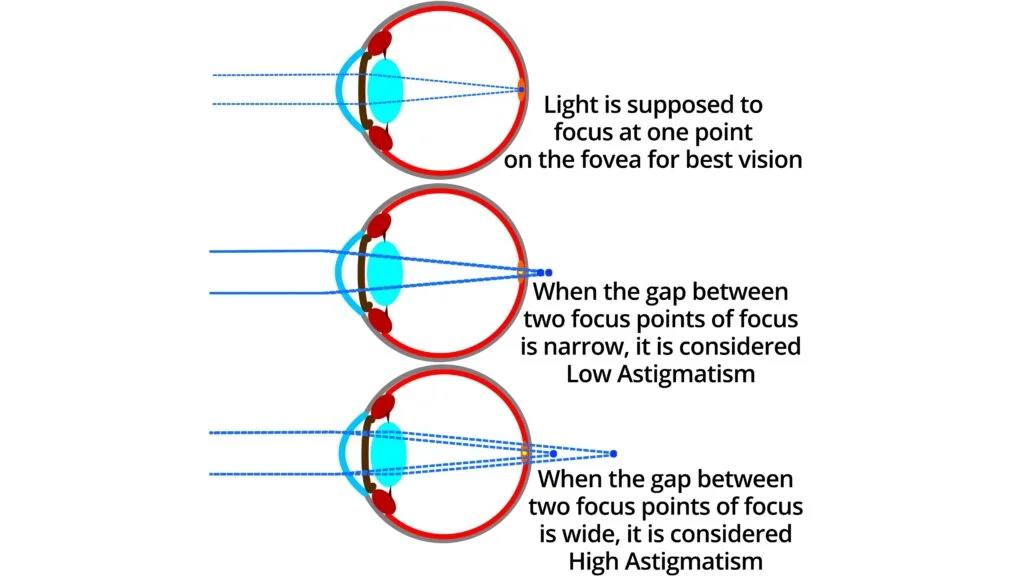
Does Astigmatism Mean that the Eye is Shaped like a Football?
NO! Astigmatism does NOT mean that the eye is shaped like a football. In fact, the overall shape of the eye is quite round. This “football-shaped” explanation is often used to describe the a very slight difference between different directional curves of a single cornea (the clear dome over the color portion of the eye – the iris – through which light enters the eye) when measured by very sensitive equipment. In one direction, the front of the cornea may be steeper than its opposing perpendicular direction. Two slightly different curves on the same cornea may the cause light to focus between two points instead of one, but it is not the only potential cause for astigmatism. Light may also be split between two points because the back surface of the cornea has different curves, or the front surface of the crystalline lens, or the back surface of the crystalline lens, or the inner layers of the lens, or any combination of any or all of them. Therefore, astigmatism does NOT mean that the eye is football-shaped, and, honestly, without qualifying the use of this reference, it is a poor analogy to describe astigmatism.
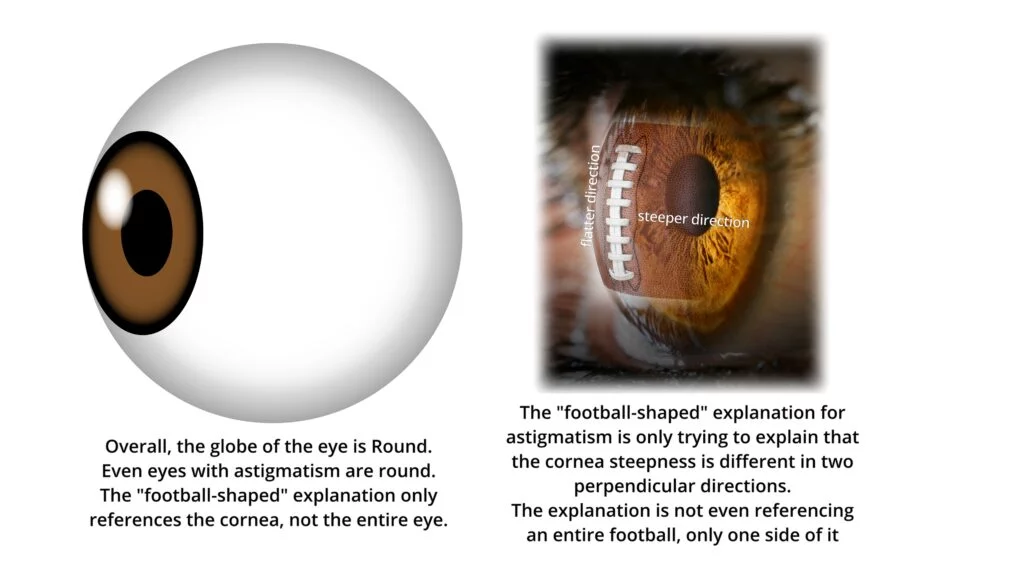
Is Astigmatism the Starburst Around Lights at Night?
NO! Starbursts around light at night can be quite natural. Atmospheric affects, dirty windows or glasses, even clean windows and glasses, our tears in our eyes, or other refractive errors can cause starbursts around lights. Therefore, starburst around lights can naturally be expected dependent on day-to-day conditions and situations. If you notice starbursts, however, it is a good idea to see an eye doctor to determine whether it is correctable astigmatism or natural phenomenon.
Why is Astigmatism Associated with Starbursts Around Lights at Night?
The reason that astigmatism is often related to starbursts at night is because astigmatism causes two points of focus in the eye. With two points of focus, astigmatism may cause starbursts around headlights to be more amplified in one direction versus another direction. With low amounts of astigmatism, this effect may go unnoticed. However, with higher the amount of astigmatism, it is easier to perceive the different starburst effects around lights in different directions, and the more likely that astigmatism can be identified. However, since various effects in the air, different transparent media (such as windows and glasses), and our own tears and eyes may also contribute to variant starburst effects, astigmatism can not be determined with any confidence by the recognition of simple starbursts. Again, an eye doctor can help determine whether astigmatism is the cause of your starbursts or not.
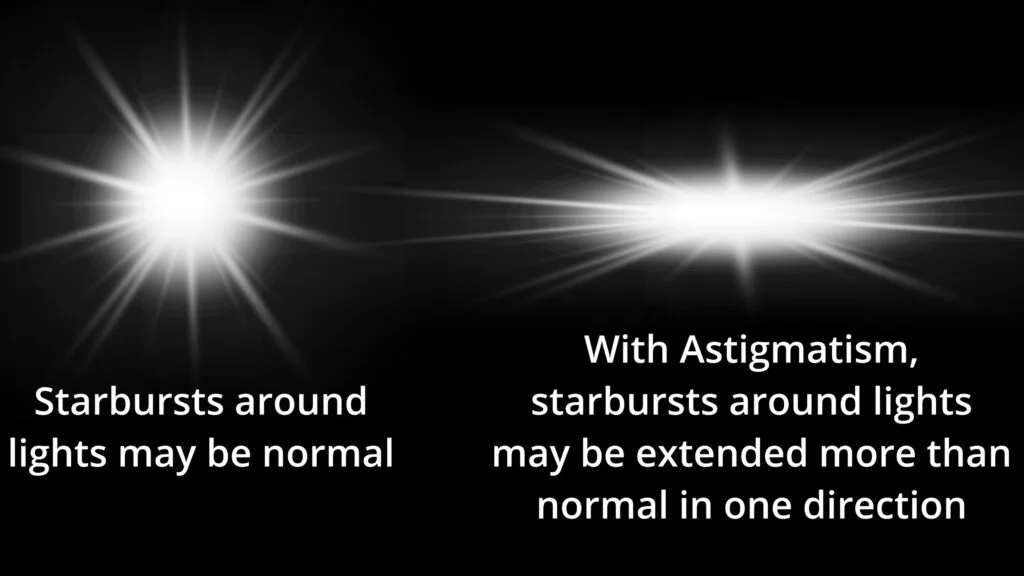
How is Astigmatism related to Farsightedness and Nearsightedness?
Remember, light is supposed to focus at a point in the back of the eye called the fovea. When a single point of light focuses behind the fovea in a relaxed eye looking at a distant object, the uncorrected focal point is termed, hyperopia (aka: farsighted). When the single focal point is on the fovea… emmetropia. When the single focal point is in front of the fovea… myopia (aka: nearsighted).
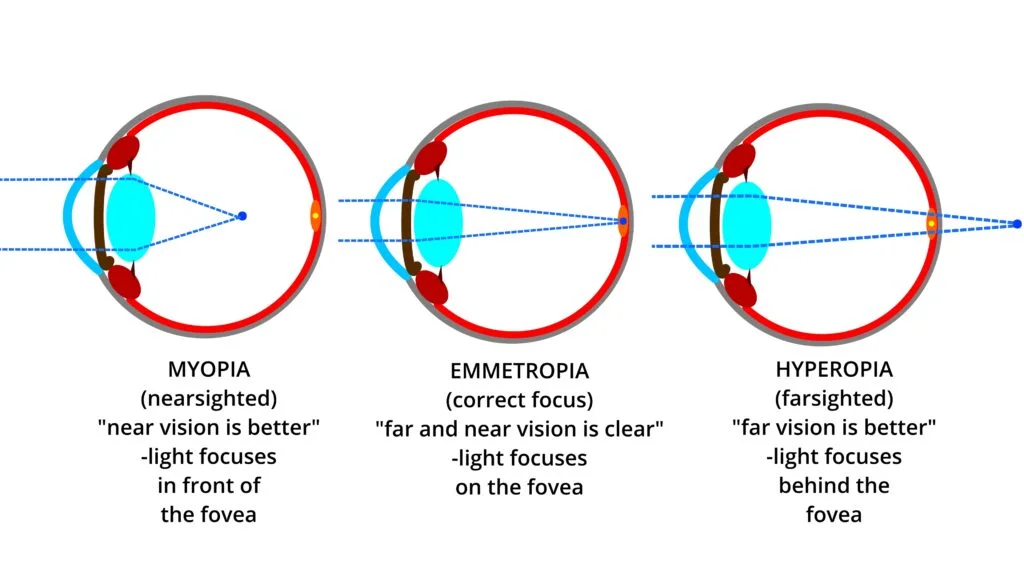
If, instead of there being one single focal point, there are two focal points of focus, then the term “astigmatism” is given. It doesn’t matter where the points are located, it only matters that the focus is stretched between two points instead of one. The unit used to measurement the gap between the points is called the diopter (often referenced by the letter “D”). A reference to where in relation to the fovea that each focal point is located is used to identify the type of astigmatism. The following are examples of these references…
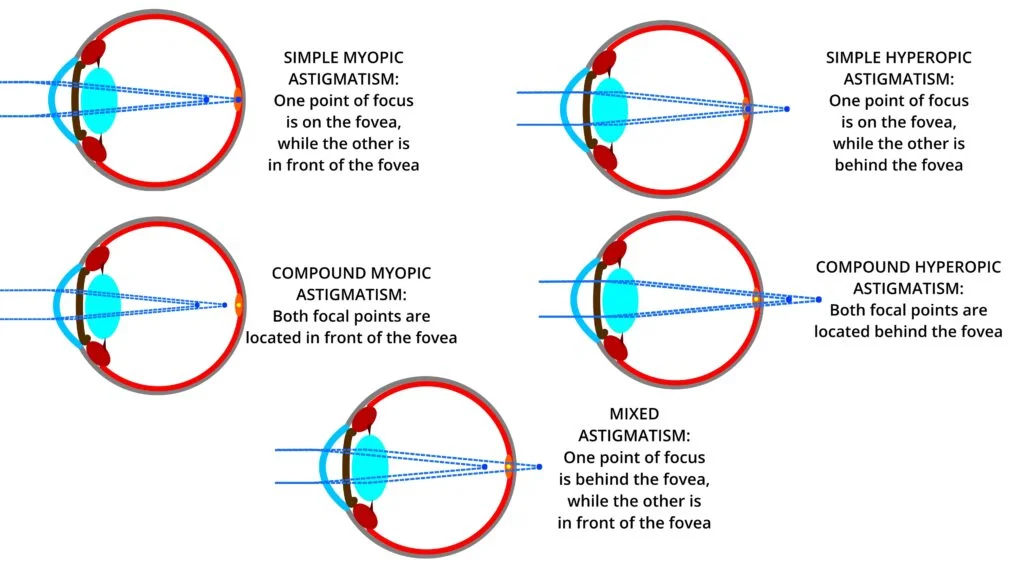
How is Astigmatism Corrected?
To correct astigmatism, the two points of light must be brought back to the fovea. Therefore, spectacle lenses or soft contact lenses must have the ability to direct each point, separately, onto the fovea. Lenses can do this because the front and back curves of the lenses can be designed to bend light variable amounts.
In an eye without astigmatism, only one point needs to be moved onto the fovea, so only one power lens is needed. This can be done by measuring the distance (using the light bending unit of the diopter, “D”) that the point is from the fovea, and placing a lens with that diopter power in front of the eye.
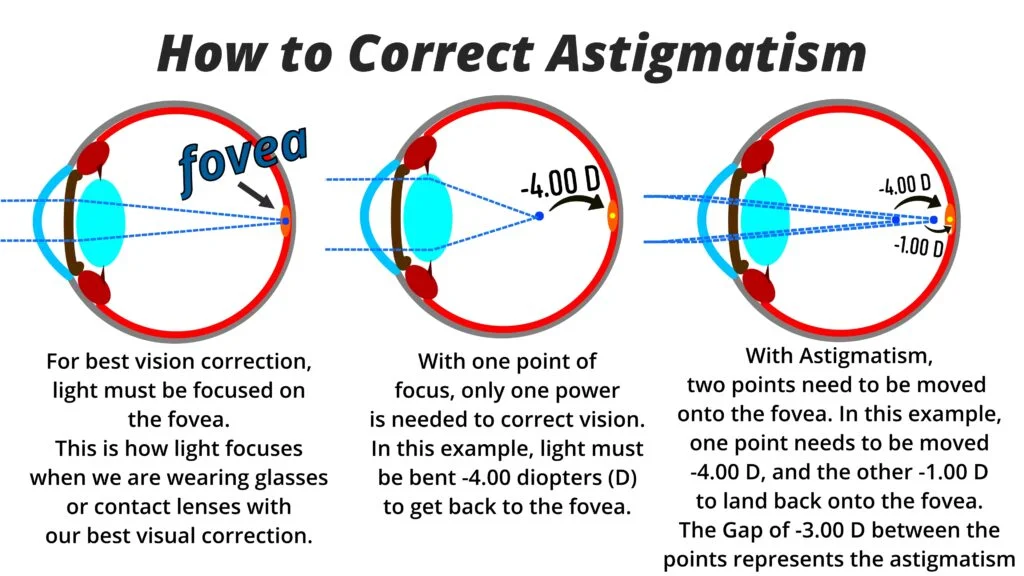
In an eye with astigmatism, since two points are out of focus and they are perpendicular to each other, then two separate dioptric powers need to be placed in the lens ninety degrees from each other and aligned with their respective focal point to move each point separately onto the fovea.
How Do Glasses Correct Astigmatism?
When spectacle lenses (glasses) correct astigmatism, the lenses can be refined to the precise dioptric power necessary to bring each separate point of focus onto the fovea, and the alignment of the lens can be fine-tuned to the precise degree necessary for perfect focus as well. There are one hundred eighty degrees of alignment possible, and glasses can align down to one specific degree, and then locked into position by the frames that hold them.
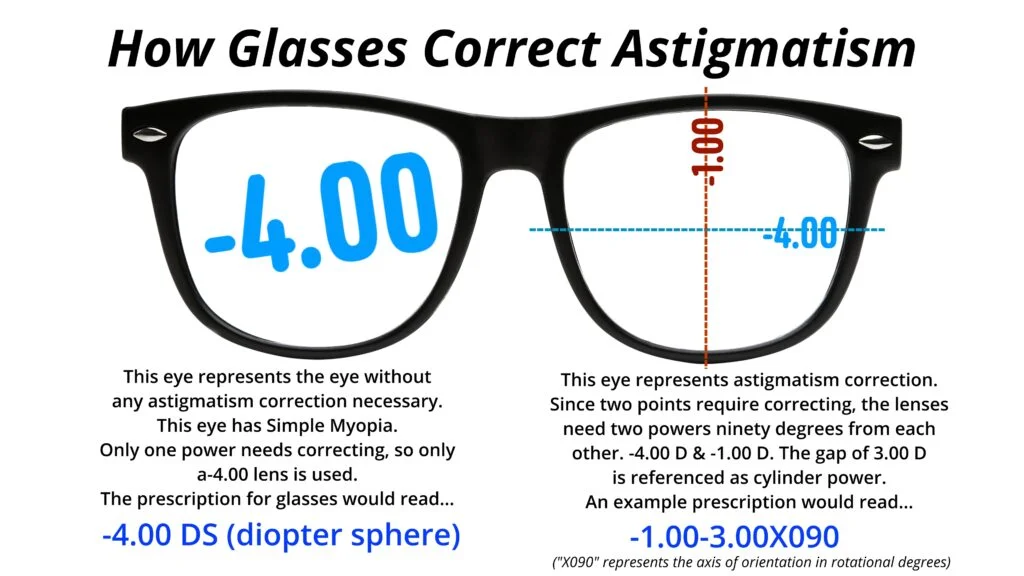
How Do Soft Contact Lenses Correct Astigmatism?
When contact lenses (glasses) correct astigmatism, however, there not all powers of lenses are available to provide the precise dioptric power necessary to bring each separate point of focus onto the fovea, and the alignment of the lens can not be fine-tuned to the precise degree either. Of the one hundred eighty degrees of alignment possible, contacts can only provide any where from five to thirty-six of these degree options, with the average availability of eighteen options. Soft contact lenses are not held into position by a frame either. No. Instead, astigmatism lenses rely upon the fitting nature of the lens design which include components such as larger lenses, special curve cuts, thicker portions, and the utilization of gravity and lid mechanics. If the lens is not in its proper position, then vision can become blurry because the correcting powers are not aligned with their respective focal points that they are trying to move.
These imperfect powers and alignment corrections may guide you to believe that soft contact lenses must be far inferior to glasses, but that is not the case. Eye doctors ask for a return visit with astigmatism fits so they can observe the small scribe marks on the astigmatism lens and, therefore, fine tune the alignment of the contact lenses. For example, if the doctor sees a returning patient one week after the initial fit wearing an astigmatism soft lens on their eye, and the scribe marks on the lens are rotated ten degrees left from their expected alignment, then the doctor can modify the fit with a different ten degree compensatory fit. On top of that, the imperfect powers and alignment are often so subtle that they are not even noticed after a good fit. Often, what is noticed and appreciated is that contact lenses provide enhanced peripheral viewing when compared to the limitation of frames with spectacle lenses.
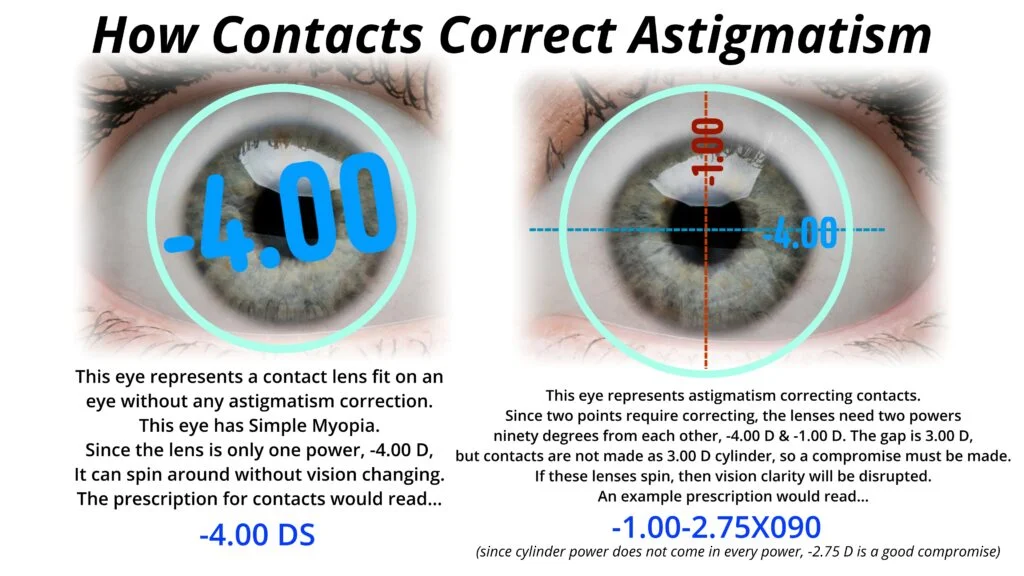
Why Do Soft Contact Lenses for Astigmatism (Toric Lenses) Have Lines on Them?
Soft Contact Lenses for Astigmatism have lines on them to not only help the fitting doctor determine a proper fit, but also to help guide the insertion of the contact lens so it doesn’t take very long for the lens to settle into its proper position. When a lens is sitting on the eye as expected, then the two powers within the contact lens are properly aligned to correct the two off-focus points onto the fovea. Soft contact lenes for astigmatism will have one, two, or three lines on them. Here is a guide of how to orient the lens upon insertion…
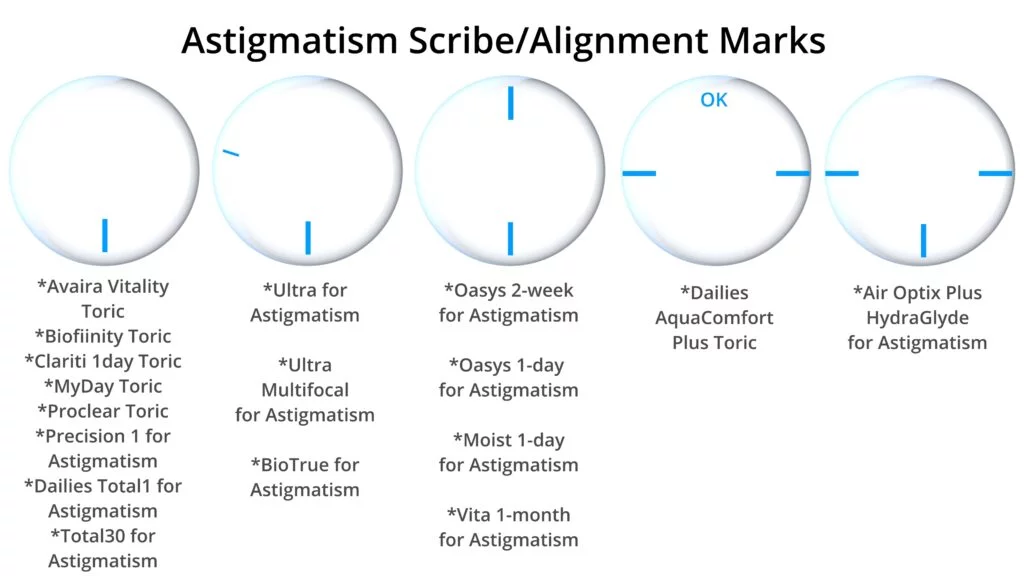
If there is 1 line… Point the one line straight down when you insert it.
If there are 2 lines… For all Acuvue Astigmatism products, insert the lines vertically (up and down), it doesn’t matter which one is up or down. For the Bausch & Lomb Biotrue & Ultra Astigmatism products, point the bigger line down (the smaller line delineates the axis of the lens). For the Alcon Dailies AquaComfort Plus Toric, insert the lines horizontally (the OK inversion indicator can be either on top or the bottom, it doesn’t matter).
If there are 3 lines… Point the middle line straight down when you insert it.
Where Should I Purchase my Soft Contact Lenses for Astigmatism (Toric Lenses)?

If you are not buying your soft contact lenses for astigmatism (or any soft contact lenses) from your eye doctor, go to DeliverContacts.com for ALWAYS LOW prices with FREE DELIVERY and the BEST CUSTOMER SERVICE. At DeliverContacts.com, the price you see is the price you get… no surprises at checkout. We don’t mess around with games and gimmicks, or price matching games, we keep our prices ALWAYS LOW. There are no codes or special discounts offered… instead, everybody gets the same low price ALWAYS. Go to the online site owned and run by eye doctors (including me)… DeliverContacts.com.

Need Consistanly Cheap Contacts?
DeliverContacts.com always guarantees you are paying low prices, every time you buy. We will never play games with our pricing or take part in manipulative discounts. Just consistently cheap contacts, forever.
Give your box a search below and see for yourself! 100% Free shipping and returns on all products!
